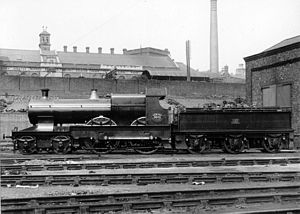
The Great Western Railway 3700 Class, or City Class, locomotives were a series of twenty 4-4-0 steam locomotives, designed for hauling express passenger trains.
George Jackson Churchward was an English railway engineer, and was chief mechanical engineer of the Great Western Railway (GWR) in the United Kingdom from 1902 to 1922.

The Great Western Railway 3252 or Duke Class were 4-4-0 steam locomotives with outside frames and parallel domed boilers. They were built in five batches between 1895 and 1899 for express passenger train work in Devon and Cornwall. William Dean was their designer, possibly with the collaboration of his assistant, George Jackson Churchward. Four prototype 4-4-0s, of the Armstrong Class, had already been built in 1894.
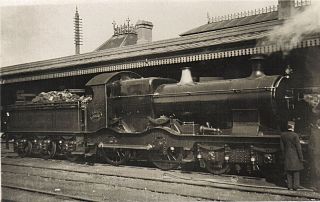
The Bulldog and Bird classes were double-framed inside cylinder 4-4-0 steam locomotives used for passenger services on the Great Western Railway. The Bird Class were a development of the Bulldogs with strengthened outside frames, of which a total of fifteen were built. A total of 121 Bulldogs were built new, with a further twenty rebuilt from Duke Class locomotives. Thirty Bulldogs were later rebuilt as Earl Class locomotives and renumbered 3265, 3200-3228.
The Great Western Railway 3800 Class, also known as the County Class, were a class of 4-4-0 steam locomotives for express passenger train work introduced in 1904 in a batch of ten. Two more batches followed in 1906 and 1912 with minor differences. They were designed by George Jackson Churchward, who used standard components to produce a four-coupled version of his Saint Class 4-6-0s.

The Great Western Railway 2900 Class or Saint Class, which was built by the Great Western Railway's Swindon Works, incorporated several series of 2-cylinder passenger steam locomotives designed by George Jackson Churchward and built between 1902 and 1913 with differences in the dimensions. The majority of these were built as 4-6-0 locomotives; but thirteen examples were built as 4-4-2. They proved to be a highly successful class which established the design principles for GWR 2-cylinder classes over the next fifty years, and influenced similar classes on other British railways.
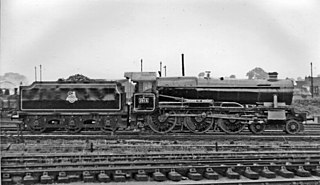
The Great Western Railway 1000 Class or County Class was a class of 4-6-0 steam locomotive. Thirty examples were built between 1945 and 1947, but all were withdrawn and scrapped in the early 1960s. A replica locomotive is under construction.

The Stephenson valve gear or Stephenson link or shifting link is a simple design of valve gear that was widely used throughout the world for various kinds of steam engines. It is named after Robert Stephenson but was invented by his employees.
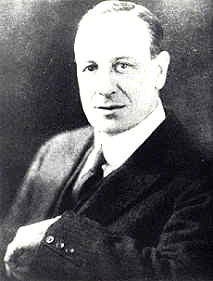
Charles Benjamin Collett was Chief Mechanical Engineer of the Great Western Railway from 1922 to 1941. He designed the GWR's 4-6-0 Castle and King Class express passenger locomotives.

The SR U1 class were three-cylinder 2-6-0 ('mogul') steam locomotives designed by Richard Maunsell for passenger duties on the Southern Railway. The fifth member of the Maunsell "family" of standardised moguls and 2-6-4 locomotives, the U1 was the final development of the Maunsell mogul, and marked a continuation of the basic principles established by CME George Jackson Churchward for the GWR. Developed from Maunsell's previous SR U class design, the U1 class shared characteristics with Churchward's GWR 4300 Class.

The B4 class were 4-4-0 steam locomotives for express passenger work on the London, Brighton and South Coast Railway. They were designed by R. J. Billinton and were either built at Brighton works 1899–1902 or else by Messrs Sharp, Stewart and Company in 1901. Twelve members of the class were rebuilt from 1922 to 1924 by L. B. Billinton with a larger boiler, cylinders and a superheater. The rebuilt locomotives were classified B4X.

The Dean Single, 3031 Class, or Achilles Class was a type of steam locomotive built by the British Great Western Railway between 1891 and 1899. They were designed by William Dean for passenger work. The first 30 members of the class were built as 2-2-2s of the 3001 Class.

The SECR N class was a type of 2-6-0 ("mogul") steam locomotive designed in 1914 by Richard Maunsell for mixed-traffic duties on the South Eastern and Chatham Railway (SECR). Built between 1917 and 1934, it was the first non-Great Western Railway (GWR) type to use and improve upon the basic design principles established by GWR Chief Mechanical Engineer (CME) George Jackson Churchward. The N class was based on the GWR 4300 Class design, improved with Midland Railway concepts.
During the 1880s and 1890s, William Dean constructed a series of experimental locomotives to test various new ideas in locomotive construction for the Great Western Railway.

The SECR N1 class was a type of 3-cylinder 2-6-0 ('mogul') steam locomotive designed by Richard Maunsell for mixed traffic duties, initially on the South Eastern and Chatham Railway (SECR), and later operated for the Southern Railway (SR). The N1 was a development of the basic principles established by the Great Western Railway's (GWR) Chief Mechanical Engineer (CME) George Jackson Churchward and by Maunsell's previous N class design.
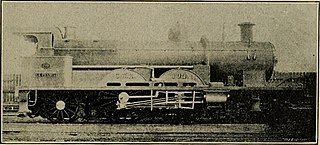
La France, number 102, was a locomotive of the Great Western Railway. It was bought by G.J. Churchward to evaluate French locomotive practice, and particularly the effect of compounding.
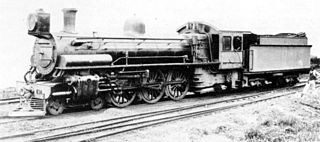
The South African Railways Class 10B 4-6-2 of 1910 was a steam locomotive from the pre-Union era in Transvaal.

The South African Railways Class 10A 4-6-2 of 1910 was a steam locomotive from the pre-Union era in Transvaal.
The GS&WR 400 class or CIE class B2/B2a were a class of ten 4-6-0 steam locomotives built for the Great Southern & Western Railway (GS&WR) between 1916 and 1923 for express passenger duties on the Dublin to Cork main line. They proved initially unreliable but rebuilds from four to two cylinders between 1927 and 1937 for the seven survivors produced locomotives yielding satisfactory performance with the last two being withdrawn in 1961.

The Midland Great Western Railway (MGWR) A Class, later Inchicore Class D5, consisted of 6 4-4-0 express passenger locomotives built at Broadstone Works in the period 1902-1905. The largest express passenger locomotive in Ireland for a short while after introduction they were used on the MGWR's flagship services to Galway with most surviving until the 1950s albeit on less prestigious work.
